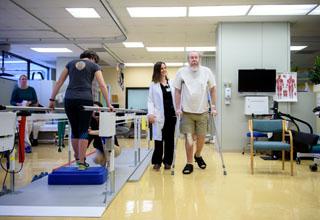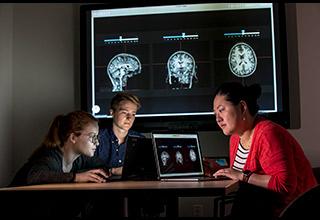Arthritis and Foot Health

Considering all that your feet do for you, foot health is an important part of your overall health. Typically, feet are the basic mode of transportation getting you to where you need to go. Even if you need to get into a car to drive somewhere, you have to actually get to that car in the first place and use your foot to operate the pedal.
Foot dysfunction leads directly and indirectly to numerous physical, psychological, and social concerns. Staying active and exercising is a preventative measure against many chronic diseases such as diabetes and heart disease. If your feet hurt, that makes exercising more difficult, so you are less likely to go out and do things. This can trigger a host of other concerns that may develop into bigger problems.
Though we tend to break down the human body into different parts and systems — digestive, circulatory, etc — all those pieces are interconnected. A problem in one part of the body can cause issues in another part. This is especially true with your skeletal system. As our feet walk on the ground, they transmit a force to the ankles which is then transferred up to the knees, hips, and eventually all the way up the spine to the top of the head. If any part of that system is misaligned — especially your feet — that will radiate through the whole body.
As Co-Director of the Musculoskeletal Research Center at Hebrew SeniorLife’s Hinda and Arthur Marcus Institute for Aging Research, my work focuses on the basic structure of the human body: bones, muscles, tendons, ligaments, and soft tissues. Early in my career, I discovered that there was a surprising lack of studies done on foot health. This led me to focus my research on feet to expand medical science knowledge as well as improve medical education.
What causes arthritis in the feet?
Just like any other joint in our body, the feet are commonly affected by arthritis as we age.
Arthritis is the swelling and tenderness of one or more joints. The main symptoms of arthritis are joint pain and stiffness, which typically worsen with age. Despite popular belief, arthritis is not a disease of wear and tear. There are a few factors that contribute to it: genetics and family history, occupational/repetitive injury, and overall injury.
If someone had a job or played a sport that put repeated stress on their feet, that could lead to joint injury and arthritis. Overall injury would be an injury to the joint itself, such as a dislocated toe, bone fracture, or sprained ankle. Motor vehicle accidents that affect the feet or ankles are one type of injury that has been linked to foot arthritis. If the joint does not fully recover or adapt well after the injury, that can cause problems later on.
How can you keep your feet healthy?
While we can’t change our genetics, we can change the demands on our feet.
For arthritis, preventative measures are the best thing to do. While walking and staying active is the primary preventative tool, protecting your feet is also key. This involves protecting against injury, such as wearing foot supports (braces or insoles for example) and proper footwear when playing sports or doing repetitive work. For those who are on their feet all day for work, anti-fatigue mats in well-trafficked areas help reduce the strain on your feet. Replacing supportive footwear that is worn down is important as well. Essentially, you want to keep muscle and tendons in shape to allow a full range of movement.
If a family history increases your likelihood of having arthritis or skeletal malalignment, it is helpful to address the misalignment through physical therapy early in the course of the disease. It may not keep you from getting the disease, but it may delay its onset. Also, keep an eye on how your shoes wear down — does the outside or inside edge wear more quickly than other parts of the sole? Uneven wear is a sign that you may need more support to prevent misalignment in your joints.
Physical therapy is also good for improving your balance so you can safely walk around. Whether you’re recovering from foot surgery or dealing with a more long-term condition like a bunion, therapists can help you increase mobility by improving your strength and range of motion. They can also help you retrain your gait to minimize the likelihood of injury later while maximizing your current mobility.
What can we do about foot pain?
At the Marcus Institute, my team and I are researching foot disorders, foot pain, and physical limitations in older people. One long-term NIH-funded study, the Framingham Foot Study, uses data collected from more than 3,000 adults as a subset of the famed Framingham Heart Study to examine the effect of age, sex, and race on biomechanical foot measures, and to look at how those data relate to functional limitations. Another study involved researching the genetics of foot disorders to understand the heritability of specific foot disorders.
This research will hopefully improve the prevention and treatment of foot disorders, including arthritis, in the future, but there are some things you can do now to address foot pain.
Medications
There are a few medications used to treat arthritis. They are available over the counter or through a prescription from your doctor. Medications used for arthritis include:
- NSAIDs. Nonsteroidal anti-inflammatory drugs (NSAIDs) can relieve pain and reduce inflammation. Examples include ibuprofen (Advil, Motrin IB, others) and naproxen sodium (Aleve). However, NSAIDs can cause stomach irritation and may increase your risk of heart attack or stroke so you should speak with your doctor to find out what will work for you. NSAIDs are also available as creams or gels (e.g. Voltaren), which can be rubbed on joints.
- Counterirritants. Some varieties of creams and ointments contain menthol or capsaicin, the ingredient that makes hot peppers spicy. Rubbing these preparations on the skin over your aching joint may interfere with the transmission of pain signals from the joint itself.
- Steroids. Corticosteroid medications, such as prednisone, reduce inflammation and pain and slow joint damage in advanced disease. Corticosteroids may be given as a pill or as an injection into the painful joint. Side effects may include thinning of bones, weight gain, and diabetes.
Exercises
Exercise is the most effective method to help with arthritis. It increases strength and flexibility, reduces joint pain, and helps combat fatigue. Some good forms of exercise include:
- Body awareness exercises. Gentle forms of yoga or tai chi improve posture and coordination. They promote a strong sense of balance emanating from your feet.
- Low-impact aerobic exercises. Aerobic or endurance exercises help with your overall fitness. Walking, bicycling, swimming, or using an elliptical machine are all ways to build up cardio that won’t add extra strain on your joints.
- Range-of-motion exercises. Exercises like heel stretches, tennis or golf ball rolls, calf raises, and spelling out the alphabet with your toes relieve stiffness and increase your ability to move your foot joints through their full range of motion. They also strengthen the muscles which help stabilize the joints in the feet.
Biofeedback
Biofeedback is a behavioral therapy aimed at training different parts of your brain to react to the pain differently. Chronic pain can start to rewire the brain. By taking a mind-body approach to therapy, it improves both physical and mental health.
Essentially, biofeedback therapy works to help you to relax. The pain caused by arthritis can create stress. That stress has a way of creating tension in your body and — in some ways — makes you more sensitive to discomfort. Thus, reducing stress creates positive effects on overall health such as lowering blood pressure, steadying respiration, slowing heartbeat, and relaxing muscles.
Biofeedback therapy should only be done with a licensed biofeedback therapist, who can sometimes also be a psychologist, nurse, or physical therapist.
Footwear and proper posture
Our choice of footwear also contributes to foot issues. Tight shoes compress the feet and high heels affect posture and put extra strain on parts of your foot that it is not designed for. Supports — like custom orthotics from a podiatrist or those sold over the counter — can help fix imbalances in your gait or posture. It is important to have new shoes that fit your feet, rather than thinking, “but this is the size I’ve always worn.” Shoe sizes often change over time, so either have your foot measured for shoe size or even better, try them on for fit!
You should also consider how efforts to improve posture or support certain joints could impact other parts of your body, including your feet. For example, a knee brace helps support your knee, but can it affect your foot or hip as well? Physical therapists can address those concerns. They can also help with being fitted for a cane, and teach you how to use it so you're balanced across all the joints in your lower extremities.
Need help with aching feet?
If you are concerned about pain you are having in your feet or worried you might be at risk for arthritis, the outpatient physical therapy program at Hebrew Rehabilitation Center in Boston and Dedham can help. We offer mobility and gait assessments, treatment to improve balance and strength, and help using assistive devices like canes. Ask your doctor for a referral, call us in Boston at 617-363-8539 in Dedham at 781-234-9630, or contact us online.
Blog Topics
Learn More
Outpatient Rehabilitative Therapies
At Hebrew Rehabilitation Center in Boston and Dedham, MA, we offer adult physical therapy, occupational therapy, and speech therapy using state-of-the-art mobility and treatment equipment.

Research on Aging
At the Hinda and Arthur Marcus Institute for Aging Research, Harvard Medical School-affiliated researchers are working to uncover answers to some of the most pressing challenges of aging.





